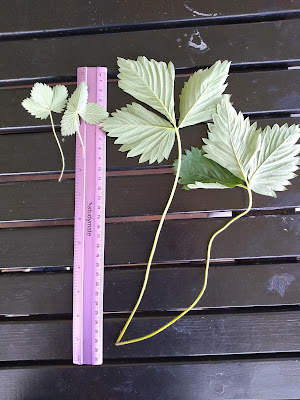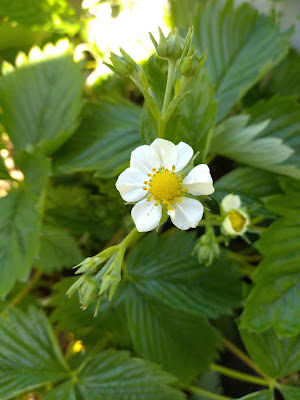I wrote a few posts about attempting to create a hybrid of raspberry and strawberry through cross pollination.
The berries themselves taste amazing and the plants are very vigorous. Without genetic testing I can not be certain that they are hybrids or if they are just weird strawberry plants that differ from the parent species.
Most produce lumpy red berries, some produce yellow/white berries, and one is producing pink berries which I have never seen before. There are a lot of odd morphological differences from the strawberry parent, plus they take a lot longer to reach maturity, they are larger, more vigorous, and more productive than the strawberry parent. While I am not yet certain if they are hybrids, I know is that they differ from the parent strawberry species in quite a lot of ways.
To be clear, this is not 'funberry' (also called "strawberry raspberry") which is not a hybrid but is a species Rubus illecebrosus that looks superficially similar to a strawberry and a raspberry. This is not a 'strassberry', which is just a variety of strawberry. This is not a Genetically Modified plant. This is a true hybrid between strawberry and raspberry that I created using simple cross pollination in my yard.
If I have created a fruiting hybrid of a strawberry and a raspberry the next logical step is to attempt to grow seed and produce some F2 seedlings. These seedlings could have any of a myriad of genetic combinations and would range from plants that contain mostly raspberry genes, to some that were half raspberry half strawberry like the parent, to some that contained mostly strawberry genes. This is an oversimplification of what could happen, but I can't go into that here.
When the hybrid started fruiting I began collecting seeds from it. I am unsure if they were the result of self-pollination, or raspberry pollen, or strawberry pollen, as there were many things flowering at the time and many insect pollinators around. I did not exclude the flowers in any way as I wanted to give them the best chance of being successfully pollinated and setting viable seed.
As no one has successfully created this hybrid and had it set fruit before there is much to be learned. More importantly, this plant if it is a true intergeneric hybrid holds a lot of breeding potential for disease resistant berries as well as amazing new tastes, but only if it either sets viable seed or if it produces viable pollen. Given that both parents were diploid and have the same chromosome count I figured that this shouldn’t be too much of an issue.
I decided if I collected 2 or 3 seeds from each berry we would still be able to eat all the berries and I would slowly get a large number of seeds. It was a rather productive little plant so it did not take me too long before I had a reasonable amount of seed to play with. The seeds were not hollow, they were plump and full, they ranged in size from tiny strawberry seed size to extra-large strawberry seed size, so I collected a mixture of all the seeds.
I usually have some success germinating raspberry seeds and often 100% success with strawberry seeds. I usually put strawberry or raspberry seeds in cold wet stratification to get them to germinate, if I leave them for too long they tend to germinate in the fridge. I also sent some of these F2 seeds to a grower friend, hopefully they get some decent results from growing them.
I put the seeds through cold wet stratification because this method works well for both parent species. Sunlight can trigger some seeds to germinate, and makes no noticeable difference to the germination of others, so I did both. Some of the seeds were left in the fridge for a longer cold wet stratification while others were planted on damp soil on the window sill where I usually germinate strawberry and raspberry seeds.
I started with many hundreds of seeds. The results were as follows:
03/03/2019 strawberry x raspberry F2 seeds put in cold wet stratification
10/06/2019 three (3) seeds germinated
No other seeds have germinated at all, only these three, which is odd. I expected a lot more seeds to germinate considering the numbers that I stratified.
None of the seedlings displayed any albinism. All three looked like small strawberry plants.
None of them have produced any runners. The strawberry line this is from produces a lot of runners in two to three months when grown from seed. These three plants are now over a year old and none have flowered while the strawberry line produces flowers in five months when grown from seed. At this stage the F2 plants are small, smaller than the F1 and smaller than the strawberry parent. I am unsure if they will stay small or if they will get larger once they mature. Given that they are well over a year old I would have expected them to reach full size by now.
From here I plan to do my best with the three that have already germinated, hopefully one of them turns into something interesting. I also plan to save some more seed and try to germinate it, I would also like to use raspberry pollen and see if that produces viable seed.
It will be interesting if any of these F2 seedlings survive to maturity to see what their fruit is like. At this stage they have survived winter and look much like strawberry plants only smaller. The strawberry parent flowers around five months when grown from seed,
this plant is sixteen months old and is still not flowering. The F1 plants flower earlier in the season and more profusely than the strawberry parent, the F2 has still not flowered.
 |
Leaf comparison: F2 hybrid on the left, F1 hybrid on the right
|
While none of this actually proves anything and there is a chance that they are not hyrbids, it all lends weight to the possibility that the parent may be a true intergeneric hybrid. If it is not a hybrid, then it is a mutant with rather frustrating timing. I sent samples of these plants for testing, so should hopefully have some answers very soon.
Edit to add: early/05/2021 flowering - over two years from seed to maturity!!! Given the parent strawberry flowers in about 5 months this is remarkable and indicative that it is a hybrid.
Edit to add: this was tested by the CSIRO. The results are on this blog post.




















